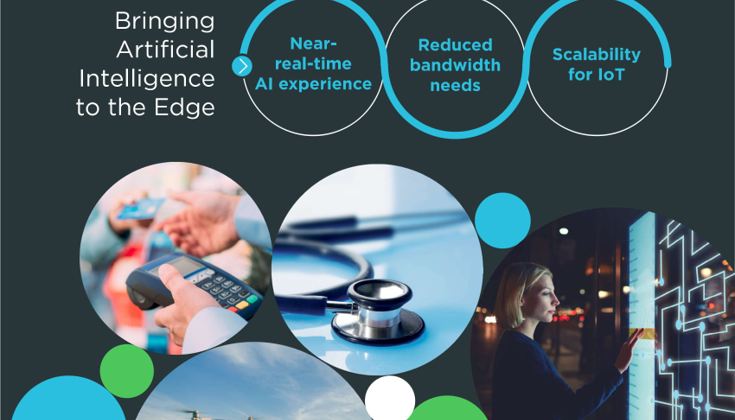
Artificial Intelligence (AI) for enterprises typically means 3 things:
- Complex or repetitive tasks automation
(extracting information from documents, scans, e-mails etc.) - Industry 4.0 automation
(intelligent cameras for visual inspections, sensors data analytics etc.) - Enabling data-driven, proactive operations
(finding answers hidden in the data like why something happened? What will likely happen? What are the trends?).
Applications like that help businesses significantly reduce costs of operations, avoid expensive and unplanned downtimes in production, leverage the information they collect anyway, gain a competitive advantage by providing more accurate answers to their clients, and the like.
All of these heavily rely on and are enabled by… the DATA. It’s the data that is processed by AI algorithms, analyzed and eventually transformed into information about shapes detected, quality issues found, information extracted etc. In other words, AI “takes” a scan of an invoice and returns information on gross and net amounts, invoice number, dates etc. The other time AI can analyze images or videos from cameras and return information about quality issues being detected, the number of objects of a certain type or even monitor production processes and trigger an alarm once something suspicious happens. Another scenario would be to analyze real-time-series data from various IoT sensors or historic data of any kind to help find the trends, predict possible future outcomes or support decisions.
AI application is as useful as accurate its responses are. However, an accurate response or a good suggestion that comes too late is of little value as well. Therefore, AI applications need to do both: provide good quality answers and do so in a timely manner.
Accuracy can be addressed with a proper selection of algorithms, data for training and through the training itself. Fast responses are typically ensured through powerful hardware infrastructure and software optimizations. However, sometimes it is not enough or even not possible to install more powerful hardware. Let’s imagine a drone that is limited in size, constrained by the energy its batteries can provide etc. Or what if our system is super optimized but needs to wait for the data as it travels through the network? Or how shall we deploy AI in environments where we need real-time responsiveness and do not want to introduce any risks related to network stability? In such scenarios, the so-called Edge Computing is the answer.
So what is Edge Computing? Edge Computing is about processing the data where it is produced. It is about building intelligent devices that can acquire the data, process it, analyze it and produce the results in real-time.
Edge Computing is also about training so that the devices can improve along the way. Meaning, they can analyze the data, collect feedbacks and over time improve the quality of generated answers. It is a very exciting approach that makes it possible for AI to process the data close to its sources. I would say it is also a very important step towards building autonomous devices.
The adoption of AI applications at the edge is driven by a rapid growth of intelligent applications and ever-increasing enterprise workloads on the cloud. Analysts say that this market will be worth $1,835 million by 2026. If you would like to know more about how Edge Computing can deliver value to your company, consider joining any of the below webinars. You can also reach out to me directly via my company’s website at www.byteLAKE.com.
Edge Computing meets Industrial IoT
Date: Thursday, March 11 and March 25, 2021
Time: 03:00 PM Central European Time
Duration: 2 hours
Register here.
More information from the website:
Implementing edge computing for industrial applications can be challenging and requires specific knowledge and optimized hardware and software solutions.
Intel and Avnet Silica organize this webinar event with a focus on Artificial Intelligence, Connectivity and Edge Computing for future-proof industrial applications. We highlight possible use cases for high-end edge computing in industrial environments.
In cooperation with partners Avnet Integrated and SECO, both members of the Intel® IoT Solutions Alliance, and AI software expert byteLAKE, we explain future proof solutions based on key technologies with high-end edge computing including machine learning with OpenVINO, functional safety and TSN (Time-Sensitive Networking) with system-on-board and system-on-modules (SOMs).
The event is intended for decision makers and engineers who need to understand the future trends for Industrial IoT in the different market segments, and also want to develop new ideas to aid in their decision making regarding the creation of their own unique products. All levels of experience are welcome from people exploring possibilities up to highly-qualified engineers.
The event consists of two parts: (1) a general session and (2) additional in depth-topics.
Join the free or charge “Edge Computing meets Industrial IoT” event in order to generate ideas for your own unique applications.
Agenda:
3PM CET: General session (50 min with Q&A)
General session with a focus on solutions and industrial applications for different market segments
4PM CET: In-depth topics with demos (20 min each)
- COM-HPC as the new Embedded Standard of modules in the industry
- Enhancing security and safety in Industrial Automation, Transportation and Medical applications
- Deploying state of the art Edge Computing solutions
Artificial Intelligence in Edge Computing
Date: Thursday, March 25, 2021
Time: 03:00 PM Central European Time
Link: https://www.youtube.com/watch?v=qp_vkrT2TIo
Another event where I will be talking about Edge Computing is organized by the Braine Project. It’s an H2020 project, focused on Big data pRocessing and Artificial Intelligence at the Network Edge. We’ll talk about the subjects from various perspectives and share our experiences in the field.
